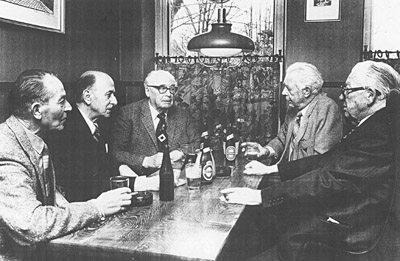| Helsingør Syklub

| | ”Helsingør Syklub” var den største og bedst organiserede flugtrute i Helsingør.
Ruten gik i opløsning i juni 1944. I mange efter Besættelsen år var der tradition for at ”Syklubben” mødtes en gang om måneden på ”Klostercafeen” i Helsingør (Klostercafeen eksister ikke mere - desværre!) |
”Helsingør Syklub” var den største og bedst organiserede flugtruter i Helsingør.
Ruten gik i opløsning i juni 1944.
Helsingør Syklub etableres
Erfaringerne fra Gilleleje indbød ikke umiddelbart til gentagelser med store transporter. Strategien blev lagt om til halvstore og helst mere hurtiggående både. Det er her ”Syklubben”, og dens leder Erling Kjær, for alvor kommer ind i billedet. Den 10. oktober anskaffede ”Syklubben” selv en båd, og Erling Kjær tog nu mere eller mindre fast ophold i Helsingborg. Han fik aftaler med de svenske myndigheder og sejlede herfra daglige ture til danskekysten, i starten i dagtimerne, både i syd og nord.
Passagerne var nu hovedsagelig militærfolk samt eftersøgte modstandsfolk. Hertil kom Kjærs rolle som ”postbud” for en korrespondance, der ikke umiddelbart var beregnet for tyske læsere.

Erling Kiær | 
Thormod Larsen | 
Børge Rønne | 
Ove Bruhn | 
Helsingør Syklub |
Faremomentet
Kjær beretter at aktiviteten i denne periode ikke var specielt farefuld, endnu da. Men efterhånden var Gestapo kommet undervejs med begivenhederne i Snekkersten med det resultat, at kroejer Thomsens fra Snekkersten Kro, blev arresteret, den 11. november 1943. Ved denne lejlighed klarede han dog frisag.
I slutningen af november forøges aktiviteten, da store dele af det danske officerskorps, herunder også den øverstkommanderende, general Knutzon, flygtede over Sundet. Risikoen var, ifølge Kjær, på dette tidspunkt øget væsentligt, da tyskerne nu afpatruljerede farvandet systematisk. I en række efterladte papirer fra kriminalassistent Thormod Larsen, ”Helsingør Syklub”, fornemmer man, i den ofte kodefyldte korrespondance, omstændighederne og stemningen omkring transporterne.
Trafikken blev nu flyttet bort fra sydkysten, og Erling Kjær sejlede i den følgende periode næsten hver nat til fra Helsingborg til Marienlyst Badehotel, lidt nord for Helsingør. I begyndelsen af december anskaffede ”Syklubben” en ny og hurtigere båd og sejlede med forskellige typer af flygtninge.
Samarbejdet med Sverige
Erling Kjær arbejdede efterhånden tæt sammen med Helsingborgs Politi: Politiintendent Friiberg, Overkonstabel Palm og konstablerne Olson og Feldt. Disse svenske embedsmænd omgik egne myndigheders krav om absolut neutralitet.
Efter nytår fik Kjær-ruten, Helsingør Syklub, officiel anerkendelse fra de svenske myndigheder i Stockholm.Fra slutningen af 1943 intensiverede tyskerne deres egen patruljering med alvorlige følger for flugtruterne.

Politimester Göte Friberg | 
Svensk humanisme |
| |
 | Lille | Stor | Carl Palm beretter om eventyreren Kiær |
Helsingør/Snekkersten-Ruterne trevles op
Den 20. januar 1944 havde ”Syklubben” planlagt to overfarter fra Hellebæk, lidt nord for Helsingør. Ved den anden transport, om aftenen, havde man undladt at koordinere aktionen med Kystpolitiets folk, og det gik derfor galt, da en tysk patrulje, som havde til huse i Hellebæk, dukkede op midt i det hele. De tyske soldater råbte an og åbnede derefter ild med det resultat, at Thormod Larsen blev ramt i underlivet og invalideret for livstid. En af passagererne blev også alvorligt såret, men transporten klarede sig over til Sverige.
En af ”Syklubbens” unge medhjælpere, Leif Olsen blev fanget, og tortureret så brutalt af Tyskerne, at han udleverede navne på de involverede personer. Omtrent en måned senere blev Kjær taget på fersk gerning i sin båd på Sundet(12.maj) og sendt i koncentrationslejr i Tyskland og samme måned flygtede lægen Gersfelt til Sverige.
I løbet af maj måned 1944 var de fleste af alle ruterne således trevlet op, og da H.C. Thomsen blev arresteret i august måned 1944, var der sat et effektivt punktum for aktiviteterne i Snekkersten. Thomsen førtes til koncentrationslejren Neuengamme i Tyskland, hvor han omkom i december samme år.
I April måned 1944 afgav, formodentlig Syklubbens kasserer Børge Rønne, en rapport til de danske myndigheder i Stockholm om Syklubbens aktiviteter.
Flugtruternes organisation og struktur i Helsingør/Snekkersten-området er ret komplicerede og lapper ofte ind over hinanden. Men bortset fra flygtningenes private aftaler med fiskerne, var det især tre persongrupper, der dominerede ruterne. Ud fra disse blev der etableret fem ruter.

Erling Kiær | 
Thormod Larsen | 
Ove Bruhn | 
Thormod Larsen og Tove Wandborg | 
Børge Rønne |
| |
 | | Stor | Interview med Tove Wandborg i 2003 |
|